Friday, April 24
■ As twilight fades, look west. Way down below Venus, near the horizon, the thin, two-day-old crescent Moon is beginning a new lunation, as shown below. Binoculars help in bright twilight, and as the sky darkens they will help show the earthshine on the Moon's nightlands before the Moon sets.
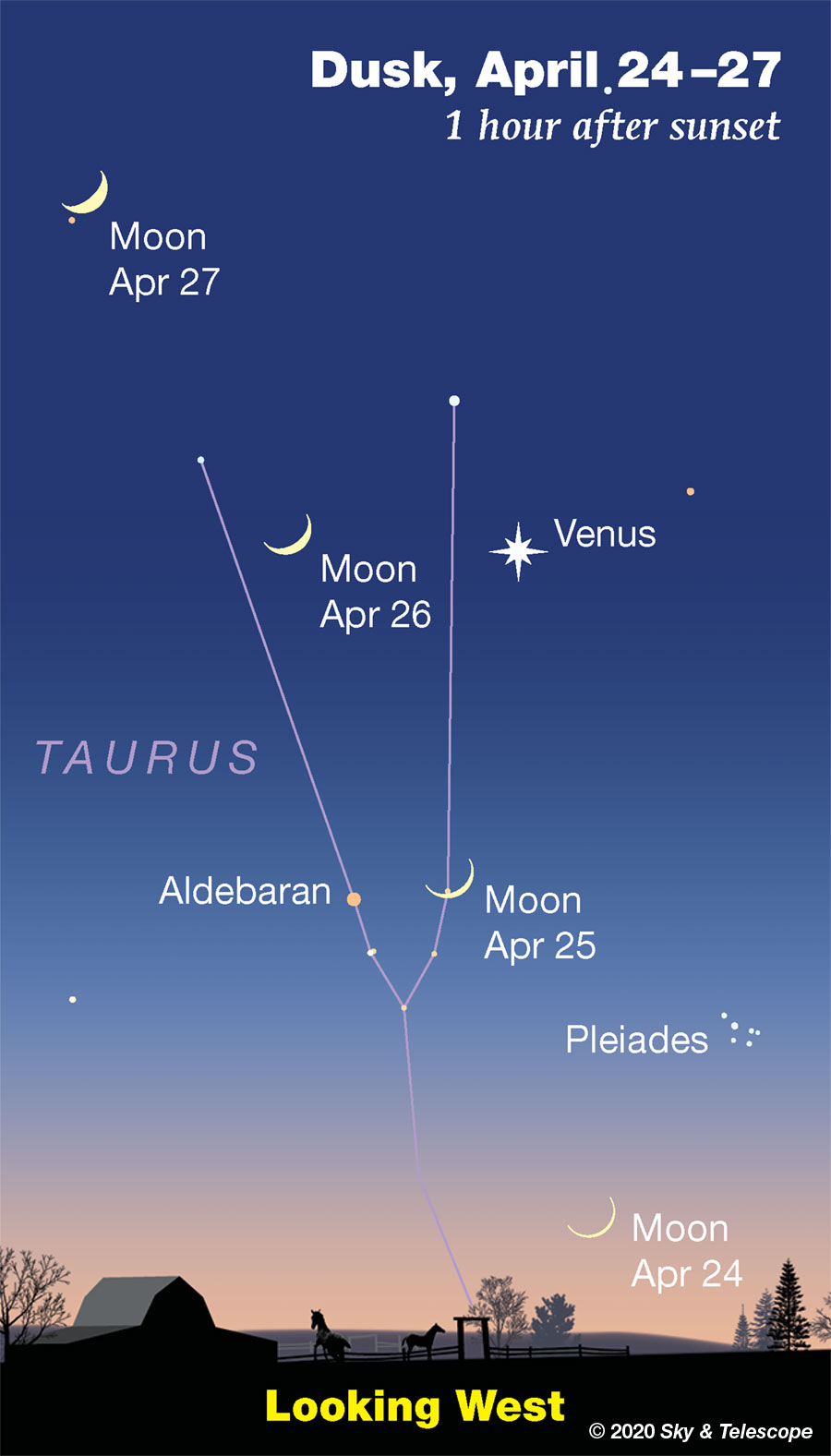
Saturday, April 25
■ The waxing crescent Moon stands with Aldebaran below Venus this evening, as shown above. The earthshine within its horns ("the old moon on the new moon's arms") will now be in much better view than yesterday. The Moon's dark limb will occult Epsilon Tauri in the Hyades, magnitude 3.5, for eastern Canada and the northernmost eastern US.
Sunday, April 26
■ Now the Moon hangs left of Venus for skywatchers in North America. They're about 7° apart. These are the two brightest predictable celestial objects after the Sun; think photo opportunity. Find some good foreground scenery to frame them in.
Also in the vicinity, much fainter, are the horn-tip stars of Taurus: Beta and Zeta Tauri, as shown above. Beta is the brighter of the two.
Monday, April 27
■ The Moon is at the feet of Gemini this evening. Venus shines to the Moon's lower right (as shown above), Capella shines far off to the Moon's right, and Procyon is far to the Moon's left.
■ Arcturus is the brightest star in the east these evenings. Spica shines lower right of it by about three fists at arm's length. To the right of Spica by half that distance, look for the distinctive four-star constellation Corvus, the springtime Crow, in the south.
Arcturus is not just the brightest star of Bootes. It's also the pointy end of the Kite asterism formed by Bootes's brightest stars. The Kite, rather narrow, lies on its side to Arcturus's left. Its head, at the far left, is bent slightly upward. The kite is 23° long: about two fists at arm's length.
Tuesday, April 28
■ Face north just after nightfall, look very high, and you'll find the Pointers, the end stars of the Big Dipper's bowl, on the meridian pointing toward Polaris straight down below. From the Pointers to Polaris is about three fists at arm's length.
Wednesday, April 29
■ Look to the right of the Moon this evening for Pollux and Castor; they're almost lined up with it. Farther to the Moon's lower left is Procyon.
Thursday, April 30
■ First-quarter Moon (exact at 4:38 p.m. EDT, in the blue sky of afternoon for the Eastern time zone). After dark the Moon is in dim Cancer, to the lower right of the Sickle of Leo.
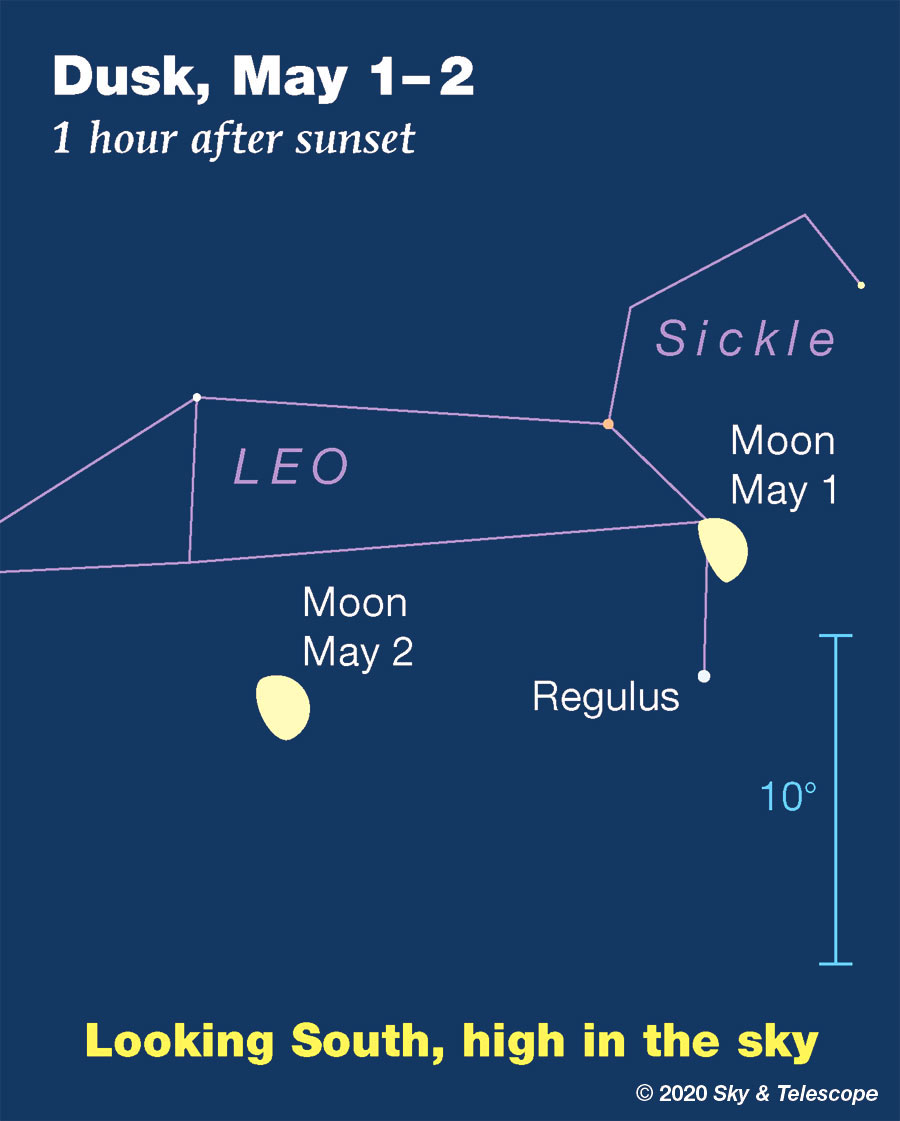
Friday, May 1
■ As the stars come out this evening, look for Regulus below the Moon. The next brightest star in Leo's Sickle is yellow-orange Gamma Leonis, Algieba, shown above.
■ Look high in the west for Pollux and Castor. They're lined up almost horizontally, depending on your latitude. These two stars, the heads of the Gemini twins, form the top of the enormous Arch of Spring. To their lower left is Procyon, the left end of the Arch. Farther to their lower right is the other end, formed by Menkalinan (Beta Aurigae) and then brilliant Capella. The whole thing sinks in the west through the evening.
Modern skywatchers are not alone in seeing the Arch of Spring as one big asterism. Extend it down past Procyon to add Sirius, and you've got the Hawaiian Canoe-Bailer of Makali‘i.
Saturday, May 2
■ Although it's May now, wintry Sirius still twinkles low in the west-southwest at the end of twilight. It sets soon after. How much longer into the spring can you keep Sirius in view? In other words, what will be its date of "heliacal setting" as seen by you?
This Week's Planet Roundup
Mercury is out of sight in conjunction with the Sun.
Venus (magnitude –4.7, in north-central Taurus) is the dazzling white "Evening Star" in the west during and after dusk. It's now as bright as it gets and will remain so for the next two weeks.
Look upper right of Venus for Capella, about two fists at arm's length away. Roughly the same distance to Venus's left is Betelgeuse. Much closer to Venus's upper left, Beta Tauri (El Nath) is moving down toward it day by day.
But Venus itself is also sinking lower. On April 24th it sets in the northwest about 2 hours after twilight's end, but by May 1st it's setting only about 1½ hours after.
In a telescope, Venus has enlarged to about 37 arcseconds in diameter while waning in phase to be a thick crescent about 28% sunlit. It's changing faster now, on its way to becoming a dramatically thin crescent low in twilight in late May as it nears conjunction with the Sun.
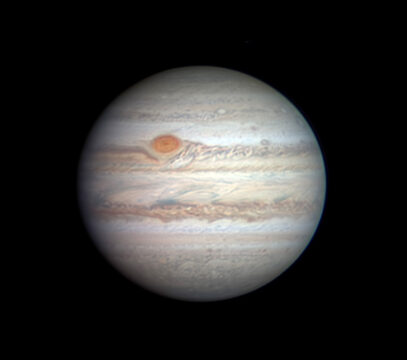
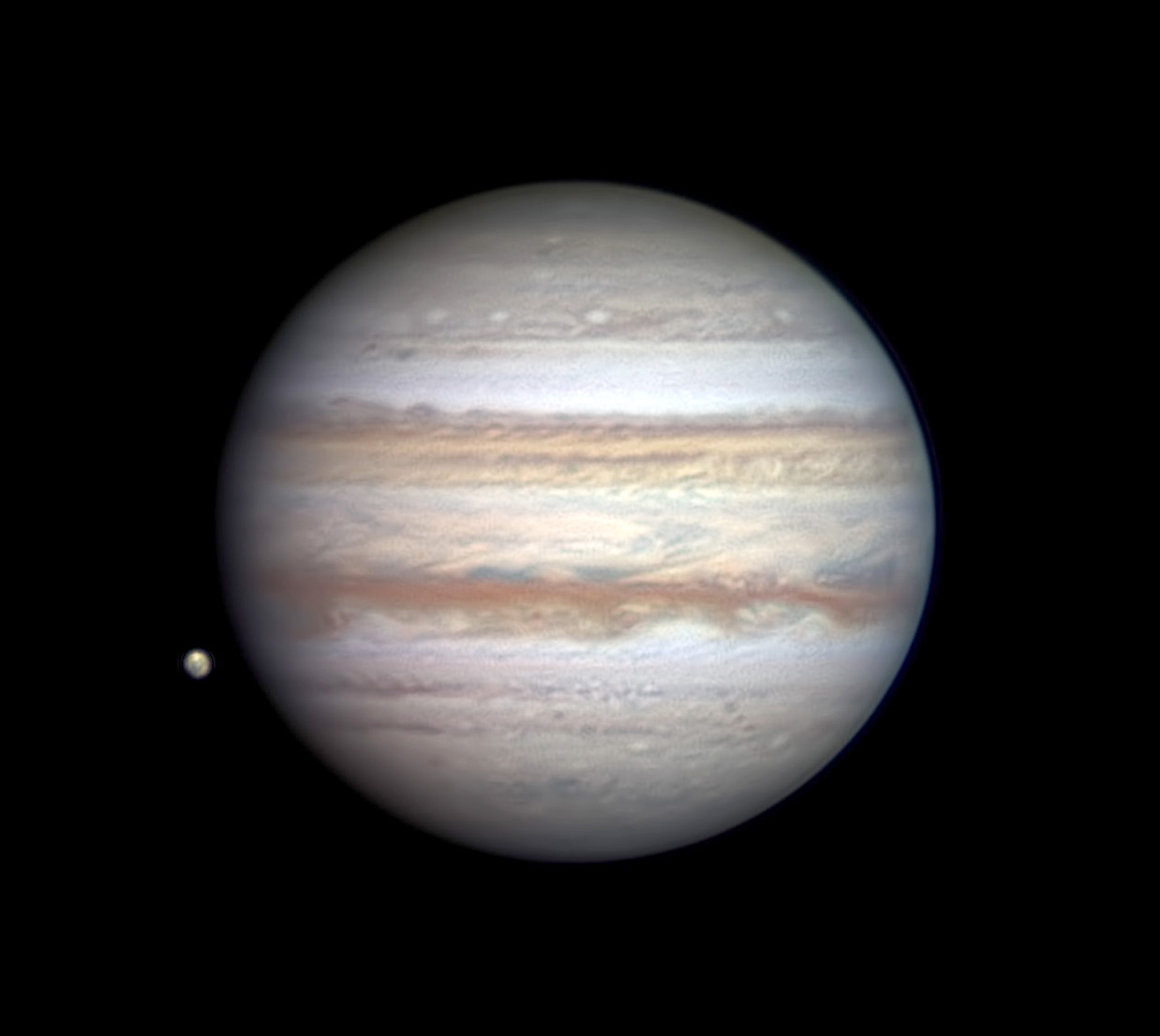
Mars, Jupiter, and Saturn (magnitudes, +0.4, – 2.3, and +0.6, respectively) shine in the southeast before and during early dawn.
Jupiter, the brightest, is on the right.
Saturn glows pale yellow 5° to Jupiter's left.
Mars is ever farther to Saturn's lower left, moving eastward against the stars away from the other two. On the morning of April 25th Mars is 16° from Saturn; by May 2nd it retreats to 21° away.
Uranus is hidden in conjunction with the Sun.
Neptune is barely risen in the east as dawn begins.
All descriptions that relate to your horizon — including the words up, down, right, and left — are written for the world's mid-northern latitudes. Descriptions that also depend on longitude (mainly Moon positions) are for North America.
Eastern Daylight Time (EDT) is Universal Time (UT, UTC, GMT, or Z time) minus 4 hours.
Want to become a better astronomer? Learn your way around the constellations. They're the key to locating everything fainter and deeper to hunt with binoculars or a telescope.
This is an outdoor nature hobby. For an easy-to-use constellation guide covering the whole evening sky, use the big monthly map in the center of each issue of Sky & Telescope, the essential guide to astronomy.
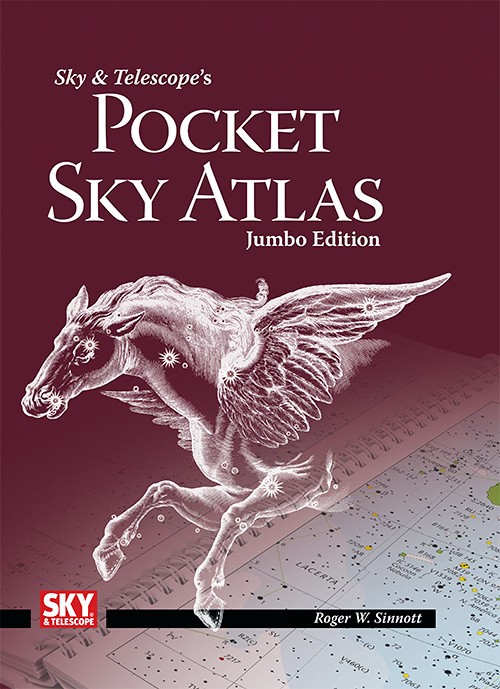
Once you get a telescope, to put it to good use you'll need a detailed, large-scale sky atlas (set of charts). The basic standard is the Pocket Sky Atlas (in either the original or Jumbo Edition), which shows stars to magnitude 7.6.
Next up is the larger and deeper Sky Atlas 2000.0, plotting stars to magnitude 8.5; nearly three times as many. The next up, once you know your way around, are the even larger Interstellarum atlas (stars to magnitude 9.5) and Uranometria 2000.0 (stars to magnitude 9.75). And read how to use sky charts with a telescope.
You'll also want a good deep-sky guidebook, such as Sky Atlas 2000.0 Companion by Strong and Sinnott, or the bigger Night Sky Observer's Guide by Kepple and Sanner.
Can a computerized telescope replace charts? Not for beginners, I don't think, and not on mounts and tripods that are less than top-quality mechanically (meaning heavy and expensive). And as Terence Dickinson and Alan Dyer say in their Backyard Astronomer's Guide, "A full appreciation of the universe cannot come without developing the skills to find things in the sky and understanding how the sky works. This knowledge comes only by spending time under the stars with star maps in hand."
![]() Audio sky tour. Out under the evening sky with your earbuds in place, listen to Kelly Beatty's monthly podcast tour of the heavens above. It's free.
Audio sky tour. Out under the evening sky with your earbuds in place, listen to Kelly Beatty's monthly podcast tour of the heavens above. It's free.
 6
6








Comments
Pencil BFB
April 24, 2020 at 9:28 am
Look at the entry for 26 April:
"Now the Moon hangs left of Venus for skywatchers in North America. They're about 7° apart. These are the two brightest predictable celestial objects after the Sun; think photo opportunity. Find some g00d foreground scenery to frame them in."
g00d?! As in G-zero-zero-D?
You must be logged in to post a comment.
New Jersey Eclipse Fan
April 24, 2020 at 6:34 pm
Hey, Pence (is it okay to call you that?), I think you have the same sense of humor as I do. But I didn't catch that one, so I guess I'm the f00l. (That's how my zeroes come out.)
You must be logged in to post a comment.
Rod
April 25, 2020 at 6:45 am
mary beth, good morning 🙂 Lovely time from 0445-0545 EDT viewing the planets with binoculars standing in wet pasture with ground fog. From my stargazing log: "Observed 0445-0545 EDT. Sunrise 0616 EDT. I used 10x50 binoculars this morning and enjoyed views of Mars, Saturn, and Jupiter along the ecliptic. Fields were very wet from rain yesterday and ground fog in the fields. Some deer were out nearby and snorted at me, they walked off and ignored me after a bit. The Stellarium 0.20.1 showed the ISS moving from SSW to E in the sky chart view. I viewed the ISS starting about 0529 EDT, low in SSW moving across to the E. The elevation angle was higher than Jupiter and Saturn near the ecliptic when the ISS passed the planets this morning along the ecliptic. I tracked the ISS from 0529 EDT until 0536 EDT when it disappeared behind a low cloud bank to the east. The ISS orbiting at 8 km/s in 7 minutes, traveled some 3360 km above the round Earth this morning while I watched (2100 miles). Earlier, near 0516 EDT, an equatorial orbiting satellite passed by moving west to east and about apparent magnitude 2.0. The ISS was as bright or a bit brighter than Jupiter when it passed above Jupiter and Saturn in elevation angle. Jupiter mv -2.31 this morning. With unaided eyes I could see Mars and Iota Capricorni star near the 10:00 position of Mars and easy with 10x50 binocular view. Mars mv +0.49, Iota Capricorni mv +4.25. They were less than 0.5 degrees apart in angular separation. An enjoyable time viewing this morning, standing in wet fields so no telescope setup. The ISS path across the sky moved through Sagittarius towards Pisces in the east. The stars and planets move westward because of Earth's rotation. The ISS is orbiting in a prograde orbit with Earth's rotation. By 0615 EDT, more ground fog all over the area now."
You must be logged in to post a comment.
mary beth
April 25, 2020 at 1:17 pm
You saw almost everything it sounds like! Always nice when the ISS makes a cameo! hope you have some of your cowboy coffee out there with you to stay awake! how was your weather looking for the next couple of nights tips are Venus?
You must be logged in to post a comment.
Rod
April 25, 2020 at 5:02 pm
mary beth, stargazing weather here looks bad. Presently cloudy with light rain moving back in for perhaps, several more days. I did plenty of pasture mowing recently and will soon be out with my trusty, STIHL super powered weed whacker, commercial grade. Kind of like Tim Allen on Tool Time. I will operate in power cut up everything mode. The grassy stuff just does not want to stop growing 🙂
You must be logged in to post a comment.
SLIMITONE
April 26, 2020 at 6:03 pm
I saw Sirius last night with my telescope. I am just a beginner, so maybe don't have the best lenses, but I have to say it was as cool as seeing saturn when I was just a kid. The brilliance of the star made me take out my telescope which I haven't done in a while. When I started trying to hone in on it, I could see the rays and from there I traced it to the star. Once focused it was such a beautiful sight. It almost appeared as if another object was slightly covering it like an eclipse. To see the 4 huge rays coming off it it pointing N, S, E & W was really awesome. I used my Iphone to take a pic of it. You could see the colors of the rainbow in the rays. It was very exciting. I will be out looking again tonight. I hope to see it again. I wish I had someone that could teach me how to use it correctly. So many beautiful sights being here in Arizona City with not a lot of city lights. Steve
You must be logged in to post a comment.
You must be logged in to post a comment.